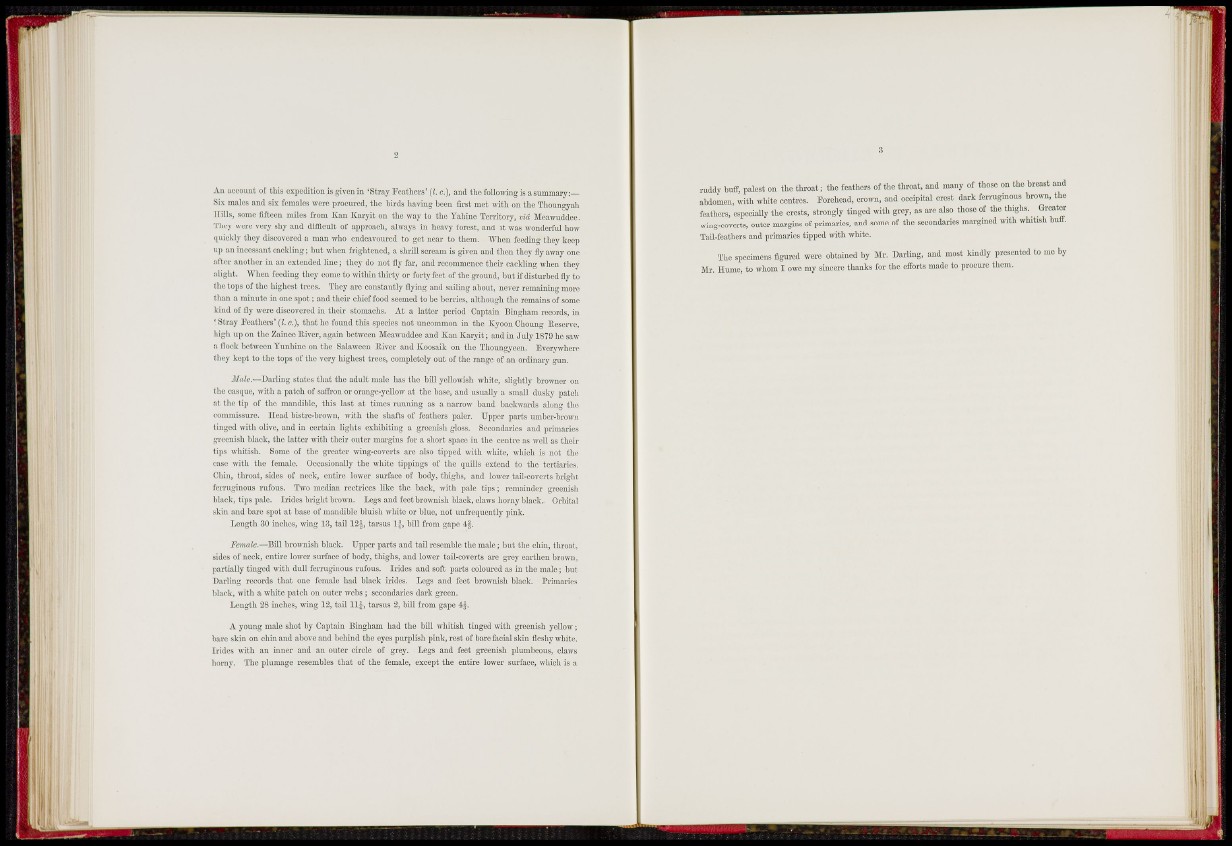
An account ol' this expedition is given in 'Stray Peathers'(i. c.), and the following is asummaiy;—
Six males and six females were pvoeured, the birds having been first met with on the Thonngyali
Hills, some fifteen miles from Kan Karyit on the way to the Yahine Territory, vid Meawuddee.
'I'kcy were very shy and difficult of approach, always in heavy forest, and it was wonderful how
(¡uiekly they discovered a man who endeavoured to get near to them. "VVhen feeding they keep
uj) an incessant cackling; but when frightened, a shrill scroam is given and then they fly away one
after another in an extended line; they do not fly fai-, and recommence their cackling when they
ali.^•ht. When feeding they come to within thirty or forty feet of the ground, but if disturbed fly to
the tops of the highest trees. They arc constantly ilying and sailing about, never remaining more
tlian a minute in one spot; and their chief food seemed to be berries, although the remains of some
kind of fly were discovered in their stomachs. At a latter period Captain Bingham records, in
' Stray leathers' {I. c.), that he found this species not uncommon in the Kyoon Choung Reserve,
high up on the Zainee llivcr, again between Meawuddee and Kan Karyit; and in July 1879 ho saw
a ilo(;k between Yunbine on the Salaween lliver and Koosaik on the Thoungyeen. Everywhere
tliey kept to the tops of the very highest trees, completely out of the range of an ordinary gim.
Male.—Darling states that the adult male has the bill yellowish white, slightly browner on
the casiiuc, with a patch of saffron or orange-yellow at the base, and usually a small dusky patch
a1; the tip of the mandible, this last at times running as a harrow band backwai-ds along the
commissure. Head bistre-brown, with the shafts of feathers paler. Upper parts umber-brown
tinged with olive, and in certain lights exhibiting a greenish gloss. Secondaries and primaries
greenish black, the latter with their outer margins for a short space in the centre as well as their
tips whitish. Some of the greater wing-coverts are also tipped with white, which is not the
case with the female. Occasionally the white tippings of the quills extend to the tcrtiai-ics.
Chin, throat, sides of neck, entire lower surface of body, thighs, and lower tail-covcrts bright
ferruginous rufous. Two median rectrices like the back, with pale tips; remainder greenish
black, tips pale. Irides bright brown. Legs and feet brownish black, claws horny black.. Orbital
skin and bare spot at base of mandible bluish white or blue, not unfrequently pink.
Length 30 inches, wing 13, tail 12J, tarsus 1;}, bill from gape
Female.—liill brownish black. Upper parts and tail resemble the male; but the chm, throat,
sides of neck, entire lower surface of body, thighs, and lower tail-coverts ai-e grey earthen brown,
])artially tinged with dull ferruginous rufous. Irides and soft parts coloured as in the male; but
Darling records that one female had black irides. Legs and feet bro%vnish black. Primaripii
black, with a white patch on outer webs ; secondaries dark green.
lA'ngth 28 inches, wing 12, tail l l j , tai'sus 2, bill from gape
A young male shot by Captain Bingham had the bill whitish tinged with greenish yellow;
bare skin on chin and above and behind the eyes purplish pink, rest of bare facial skin flesliy white.
Irides «-ith an inner and an outer circle of grey. Legs and feet greenish plumbeous, claws
horny. The plumage resembles that of the female, except the entire lower surface, which is a
ruddv buff palest on tho throat; the feathors of the throat, and many of those on the hreast and
abdomen with white centres. Porehead, cio«-n. and occipital crcst dark ferrnginons brown, the
feathers, especially the crcsts, strongly tinged with groy, as are also those of the thighs. Greater
wing-coTcrts, outer margins of primaries, and some of the secondaries margined with whitish bnil.
Tail-feathers and primaries tipped with white.
The specimens ignred wcro obtained by Mr. Darling, and most kindly presented to mc by
Mr. Hume, to whom I civo my sinccro thanks for the eilorts made to procure them.
m II ii
'h